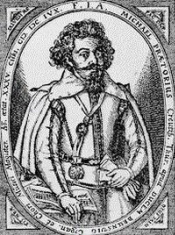|
Michael Praetorius (Composer) |
|
Born: February 15, 1571 - Kreuzberg, Thuringia, Germany
Died: February 15, 1621 - Wolfenbüttel, Germany |
|
Michael Praetorius was the son of Michael Schultze (Praetorius being a Latinization of the name). At an early age Praetorius attended the University of Frankfurt a. O., his brother supporting him.
When his brother died, Praetorius became organist at Frankfurt and later held the same post at Lüneburg. In this latter town Prätorius began his career as Kapellmeieter. In 1604 he entered the service of the Duke of Brunswick at Wolfenbüttel, first as organist, later as “kapellmeister” and secretary. He was appointed honorary prior of the Ringelheim Monastery near Goslar, but without compulsion to reside there.
Praetorius had become famous as composer of church music, among which should be mentioned the mammoth edition of over twelve hundred songs. He began to write a complete encyclopedia of the art and practice of music, of which he finished three volumes with the title Syntagma Musicum. The second volume of this work is the most elaborate and valuable of all treatises on instruments and instrumental music in the 16th century. It is considered one of the most remarkable examples of musical scholarship in existance. Among his other titles were Musae Sioniae published in nine parts and Hymnodia Sionae. He ranks high as a writer and also as a composer of church melodies. |
 |
|
Source: ELHHB Website [Dahle, Library of Christian Hymns; Handbook to the Lutheran Hymnal]
Contributed by Aryeh Oron (August 2003) |
|
Tunes used in Bach Cantatas & Other Vocal Works |
|
BWV 349 |
|
Chorale Melodies used in Bach’s Vocal Works |
|
Ach Herre Gott, mich treibt die Not (1610; Zahn 247b) |
|
Use of Chorale Melodies in his works |
|
Title |
Chorale Melody |
Year |
|
Allein Gott in der Höh sei Ehr a 12 (Musae Sioniae II), motet |
Allein Gott in der Höh sei Ehr |
1607 |
|
Allein zu dir, Herr Jesu Christ , 4-pt. setting |
Allein zu dir, Herr Jesu Christ |
1609 |
|
Christ unser Herr zum Jordan kam , Chorale Ricercare for Organ |
Christ unser Herr zum Jordan kam |
|
|
Christum wir sollen loben schon , 4-pt. setting |
Christum wir sollen loben schon |
|
|
Puer natus in Bethlehem , 4-pt. setting |
Ein Kind geborn zu Bethlehem (Puer natus in Bethlehem) |
1609 |
|
Motet for male chorus Erhalt uns Herr bei deinem Wort a 17 (Polyhymnia caduceatrix, 1619) |
Erhalt uns, Herr bei deinem Wort |
1618 |
|
O Jesu, meines Lebens Licht , 4-pt. setting of a completely different melody (the text is slightly different as well) |
Herr Jesu Christ, meins Lebens Licht |
|
|
In his Polyhymnia Panegyrica there is an item # 32 which is Gelobet seystu Jesu Christ and is listed for performance with 2, 3, 4, or 5 ‘chori’ [which means instrumental groups] and set for 8, 9, and up to 20 voices/vocal parts]
In his Polyhymnia Exercitatrix, there is a listing of a Gelobet Jesu Christ in 3 parts for 2, 4, and 6 voices. Praetorius explains that these compositions are particularly suitable for boys (‘and other musicians’) and are set according to the current Italian manner/style (Gabrieli, etc.). In his Polyhymnia X containing almost exclusively Latin motets, there is one composition with 8 vocal parts and 2 chori entitled: Gelobet seystu Jesu Christ
In his Syntagma musicum Volume III, p. 181, Praetorius writes regarding Gelobet seystu Jesu Christ and a few other chorales can also be sung without Ornament-Instrumenta [‘obbligato instruments’] using only the Concertat-Stimmen [‘solo voices’] with an organ or other Fundament-Instrumenten [‘instruments in the basso continuo group’] very distinctly and gracefully/delicately [“zierlich”] as it is appropriate and with a ‘pure’ [‘clean intonation’ and/or ‘without the use of embellishments’] voice. On p. 186, Praetorius suggests the Gelobet seistu Jesu Christ can be performed as follows: Have the singers and/or choirs (including the instrumentalist choirs) sing and/or play the first line of the verse Gelobet seist du, Jesu Christ, after which an instrumental ritornello is played. Then the entire musical group begins, once again, from the beginning to continue through the entire verse. Or, the ritornello can be inserted between the lines Das hat er alles uns gethan and the continuation of it in seine grosse Lieb zu zeigen an. |
Gelobet seist du, Jesu Christ |
|
|
Ich Steh an deiner Krippen hier , setting for choir |
Ich steh an deiner Krippen hier |
|
|
Kommt her zu mir, spricht Gottes Sohn , 4-pt. vocal setting in Musae Sioniae VII |
Kommt her zu mir, spricht Gottes Sohn |
|
|
4-pt. setting of Lobt Gott, ihr Christen, allzugleich |
Lobt Gott, ihr Christen, allzugleich |
1609 |
|
Meine Seele erhebt den Herren , 4-pt setting |
Meine Seele erhebet den Herren [The German Magnificat] |
1607 |
|
Mit Fried und Freud ich fahr dahin , 4-pt. chorale setting |
Mit Fried und Freud ich fahr dahin |
|
|
Nun komm, der Heiden Heiland , for 4 voices (from Musae Sioniae 5) |
Nun komm, der Heiden Heiland |
1607 |
|
Nun komm, der Heiden Heiland , for 6 voices (from Musae Sioniae 5) |
Nun komm, der Heiden Heiland |
1607 |
|
Nun komm, der Heiden Heiland , a 3 |
Nun komm, der Heiden Heiland |
|
|
Nun komm, der Heiden Heiland (from the Polyhymnia caduceatrix) |
Nun komm, der Heiden Heiland |
|
|
Vater unser im Himmelreich , for organ |
Vater unser im Himmelreich |
|
|
Vater unser im Himmelreich , for double-choir from "Urania" Nr. X |
Vater unser im Himmelreich |
1613 |
|
Links to other Sites |
|
Evangelical Lutheran Hymnary Handbook - Biographies and Sources (ELHHB) |
|
Bibliography |
| |